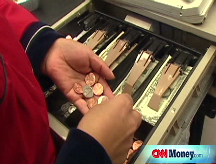Treasurys down after $30B auction
Yields rebound amid signs of more debt in the offing.
NEW YORK (CNNMoney.com) -- Treasury prices fell Wednesday - after a record $30 billion auction of 3-year notes - amid speculation that the new president will increase debt sales.
Meanwhile, bank-to-bank lending rates eased.
Bids for the $30 billion sale were 2.21 times the amount of the sale, a statistic known as the bid-to-cover ratio.
That was higher than the 2.15 ratio in December, but still weaker than some had expected following strong auctions on Tuesday.
Yields rose on the assumption that President-elect Barack Obama will increase debt sales as the government spends more cash and slashes taxes to encourage growth of the U.S. economy.
The demand for ultra-safe Treasurys outpaced supply in 2008, and yields on all maturity notes fell to record lows, prompting some retreat in the new year. In fact, Treasurys have already declined for four sessions in a row.
"Investors have been flocking to Treasurys as a flight to safety," said Dave Hinnenkamp, CEO of KDV Wealth Management. "The pendulum has swung so far that they're starting to feel some confidence and want to take some risk."
Investors are putting their money into corporate bonds, municipals and commodity stocks, which are higher-risk than Treasurys but still lower volatility than other markets, Hinnenkamp said.
"The Fed has discouraged us from being invested in Treasurys by slashing rates," he said. "The flock to safety feels good for a while, but when you're getting less than 1% on your money, you might start to look elsewhere."
In December, investors were so jittery that they were willing to essentially pay the government to hold their assets. The 3-month yield hovered around the 0% mark throughout the month and yields on some of the other shorter-term bills actually turned negative.
Treasury sold $53 billion worth of short-term notes Monday and $32 billion of government debt Tuesday. An auction of $8 billion in inflation-indexed notes Tuesday drew a yield of 2.25%, and bids were 2.48 times the available debt. That shows investors' concern that inflation will increase, as does government spending.
Bond prices and yields: The price on the benchmark 10-year note sank 9/32 to 111-9/32, and its yield rose to 2.49% from 2.48% late Tuesday.
Bond prices and yields move in opposite directions.
The 30-year bond fell 26/32 to 128-16/32 and its yield edged up to 3.07% from 3.04% Tuesday. The price of the long bond sank almost 5 points Monday as investors dumped the longer-maturity Treasury, and moved into others, such as high-grade corporate bonds, which are more profitable.
The 5-year note dipped 7/32 to 99-9/32 and its yield inched up to 1.66%.
Meanwhile, the 3-month yield - widely considered a gauge of investor confidence - slipped to 0.11% from 0.14% late Tuesday.
Hinnenkamp predicted the market will continue to ease as investors look to companies' fourth-quarter earnings reports, the planned stimulus package and the promise of a new presidential administration.
"It's a period of time when investors really want to be confident," he said. "There's still a lot of uncertainty, but hope has returned."
Credit: The 3-month Libor was little changed at 1.40%, its lowest level since June 2004. The overnight Libor fell slightly, to 0.11% from 0.12% Tuesday.
Libor - the London Interbank Offered Rate - is a daily average of rates 16 different banks charge each other to lend money in London, and it is used to calculate adjustable-rate mortgages. More than $350 million in assets are tied to Libor.
Libor rates have leveled off after a huge spike in October during the height of the credit crisis, as central banks across the world have worked to raise capital and inject liquidity into the global economy.
The 3-month Libor stood at 2.19% just a month ago. And on Oct. 14, the measure reached 4.82%, the highest since mid-December 2007.
Market gauges: Two market gauges fell, signaling investor confidence and more cash available to lend.
The "TED spread," a measure of banks' willingness to lend, slipped to 1.3 percentage points from 1.33 late Tuesday.
The higher the spread, the less willing investors are to take risks. The rate has skyrocketed as the credit crunch spiraled into a crisis, but it has fallen since the government put trillions of dollars into programs designed to loosen credit over the past few months.
Another indicator, the Libor-OIS spread, sank to 0.94 percentage point from Tuesday's rate of 1.23 percentage points. The Libor-OIS spread is a measure of how much cash is available for lending between banks. It's used for determining lending rates. The bigger the spread, the less cash is available for lending.
"The Libor rates have been static, which is neither good neither good nor bad," said Art Hogan, chief market strategist at Jefferies & Co. "The trend of the spreads is not indicative of overall easing, and I think they'll have to tighten more for us to see a change."
The Libor rates stand well above their central bank benchmarks, however, signaling that the worldwide financial system is still under stress. The Federal Reserve, the European Central Bank and the Bank of England have all cut interest rates and made additional credit available to banks in hopes it will spur lending. ![]()



